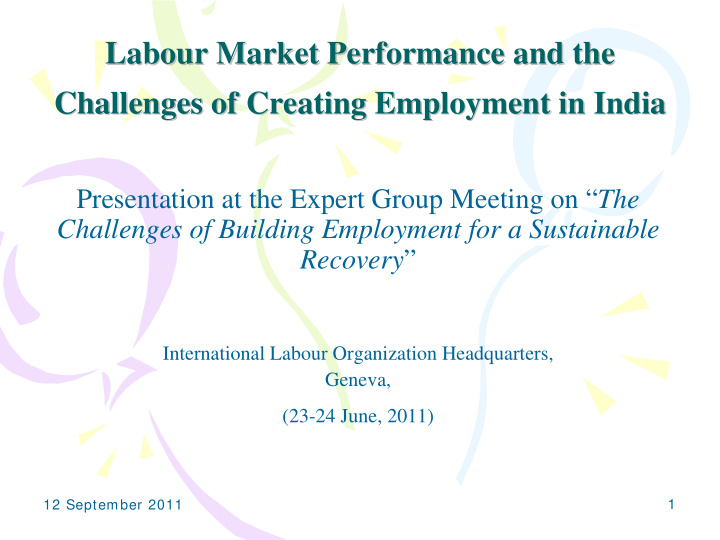



Labour Market Performance and the Labour Market Performance and the Challenges of Creating Employment in India Challenges of Creating Employment in India Presentation at the Expert Group Meeting on “ The Challenges of Building Employment for a Sustainable Recovery ” International Labour Organization Headquarters, Geneva, (23-24 June, 2011) 1 12 September 2011
Structure of Presentation • Labour Market Performance – Unemployment Rate – Occupational Diversification – Wages • Employment Challenges – Problems with School Education – Problems with Skill Enhancement • Policy Implications • Recent Activities of IAMR Related to Employment – Evaluation of ITIs and ATS (Completed) – Census of Vocational Training Providers and Skill Gap Analysis (Ongoing) • Other Activity of IAMR (India-HDR) 12 September 2011 2
Labour Market Performance GDP Growth (%) per annum Growth in Employment (%) per annum 1960s 3.5 1977-78 to 1983 2.0 1970s 3.5 1983 to 1987-88 1.5 1980s 5.6 1990s 5.7 1987-88 to 1993-94 2.2 2002-3 to 2006-7 7.8 2007-8 9.3 1993-94 to 1999-2000 1.2 2008-9 6.8 1999-2000 to 2007-8 1.4 2009-10 8.0 2010-11 8.6 12 September 2011 3
Labour Market Performance • High Unemployment rate despite significant GDP growth – Service sector led GDP growth (more than half of GDP accounted for by service sector) – Labour intensive industries have lagged behind in terms of growth – Average growth rate for the last 6 years shows agri, forestry, fisheries (3.5%), mining and quarrying (5.1%). On the other hand trade, hotel, transport, communication (10.5%), and finance, business, insurance, real estate (11.8%) • High unemployment rate among SC and ST social groups. In 2007-8 unemployment rate (by CDS) RURAL URBAN SC – 12% SC – 10.1 ST – 7.5% ST - 10.0 Others – 6.4% Others – 6.0 12 September 2011 4
Labour Market Performance • Occupational Diversification – Increasing importance of rural non-farm sector Distribution of Population by Occupation Type (Rural) 1993-4 2007-8 Self-employed in non-agriculture 13.1 15.2 Self-employed in agriculture 42.4 39 Agricultural labour 27.5 25.1 Other labour 7.5 11.3 • Regular wage employment lowest among STs (7%) as against 24% for Others 12 September 2011 5
Labour Market Performance • Considerable section of workers employed in low wage jobs – 22% of workers living below the poverty – Incidence of poverty highest among casual workers (32%) • Wage difference across occupation and gender ( NSS Report No. 531 ) Employment Rural wage (Rs) Urban wage (Rs) male female male female Regular wage 175 108 276 213 Casual labour in 76 71 - - public works (rural) Casual labour in 67 48 87 51 other works 12 September 2011 6
Challenges in Creating Employment • Lack of school education – Mean years of schooling 4.2 years – Drop-out rate 20% (6-17 years) – Financial constraint an important reason for discontinuation – Government schools do not have adequate infrastructure and teacher absenteeism high – Rapid expansion of private un-aided institutions with higher fees • One-third of workforce of 395 million in unorganized sector illiterate 12 September 2011 7
Challenges in Creating Employment • Serious problems with technical education system affecting skill development – Already shortage of skilled manpower in the country – Predominance of private institutions with high fee structure – Curricula mostly outdated – Inadequate infrastructure – Mismatch between training and requirement of the industry – Absence of interaction between industry and training institution 12 September 2011 8
Policy Implication • School education – Public expenditure on school education should go up – Kothari Commission (1966) recommended 6% of GDP to be spent on education. It has mostly been around 3% • Unskilled employment – Public work programmes like MGNREGA – Such programmes also create productive assets in rural areas • Skill enhancement – Periodical training of the workers – Accreditation system to recognize informally acquired skills – Upgradation and modernization of institutions through greater linkages with industries – ITIs taken up by Govt (100) in 2005-6 and World Bank (400) in 2006-7 to convert them into Centres of Excellence 12 September 2011 9
Recent Activity of IAMR • Evaluation of Industrial Training Institutes and Apprenticeship Training Scheme – Low Female Participation ( few ITIs for women, infrastructure bottlenecks like no hostel facilities for women, few trades which suits females) – Students mostly come from poor economic background, agriculture being the principal occupation – Vocational education and training is looked extremely down up on, like a last resort – Quality of practical learning weak ( only 10% of teachers are degree holders, weak institute-industry linkage and outdated workshops, no training in soft skills ) – Most employment in unorganized private sector with low salary 12 September 2011 10
Recent Activity of IAMR • Census of Vocational Training Providers (VTPs) and Skill Gap Analysis – Pilot survey in two Districts of India – Will be scaled up to include many more districts once the methodology is finalised – The objectives are • To create a database of VTPs in both formal and informal sectors • What type of courses are being offered and their relevance in terms of employment • Whether VTPs have sufficient infrastructure and skilled trainers • What kind of interventions can improve the functioning of VTPs 12 September 2011 11
Other Activity • India Human Development Report – Only the second report, earlier one was published in 2001 – The focus this time is on social inequalities and religious inequalities – Brings out the non-inclusive character of growth in India – Highlights the fact that there exists a synergy across various socio-economic sectors which operate in the form of feedback loop in terms of both input and output in the development process. Input in one sector has its influence in other sectors. – There are certain sections of the society which suffer from multiple deprivation 12 September 2011 12
Recommend
More recommend